|
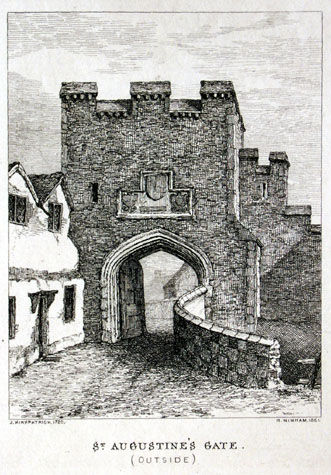
[1] View of the outside of St Augustine's
Gate about 1720 engraved by Henry Ninham from the drawing by John
Kirkpatrick [Norwich Castle Museum and Art Gallery
1954.138, Todd 5, Norwich, 113a]
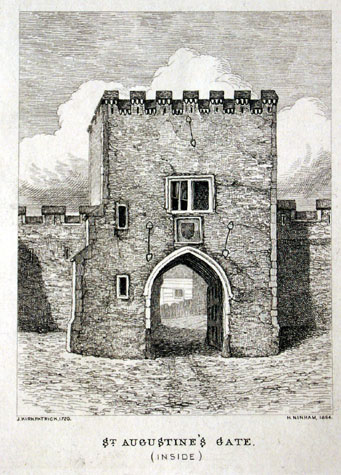
[2] View of the inside of St Augustine's Gate about 1720 engraved by
Henry Ninham from the drawing by John Kirkpatrick [Norwich Castle Museum and Art Gallery
1954.138, Todd 5, Norwich, 113b]
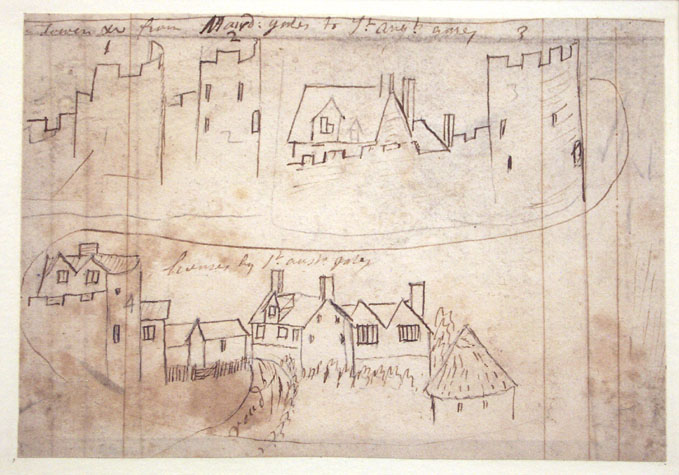
[3] Detail of Kirkpatrick's sketch of the gate about 1730. [Norwich Castle Museum and Art
Gallery 1894.76.1686:F]
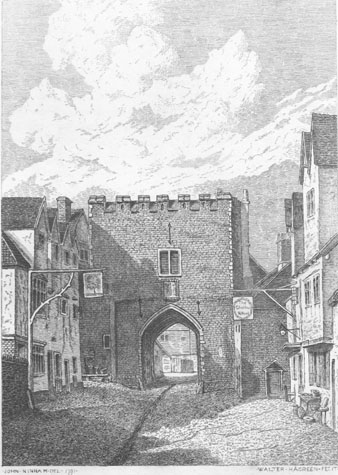
[4] View of the inside of the gateway in
1791 by John Ninham published by Fitch.
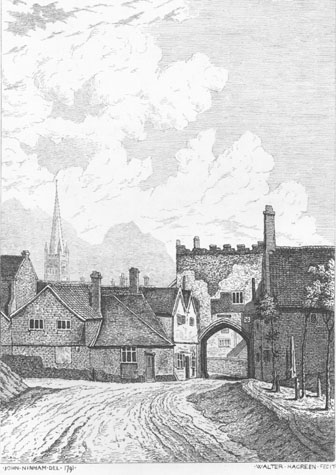
[5] View of the outside of the gateway in
1791 by John Ninham published by Fitch in 1861.
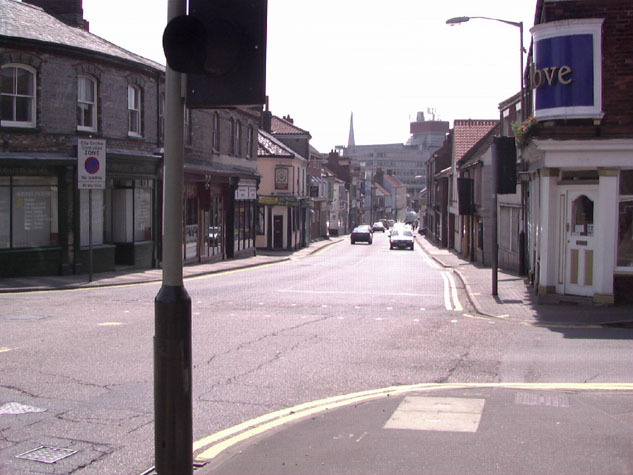
[6] View from the north looking towards the site of the gate from outside the walls.
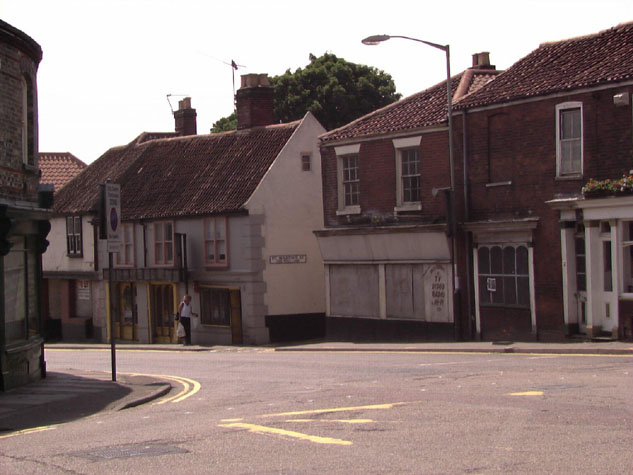
[7] The site of the gate from the north east from outside the line of the city wall.
|
General Description
The engraving of the outside of the gateway
by Henry Ninham, based on the drawings made by John Kirkpatrick in the
1720s, shows that the gate was set forward of the flanking walls. [1]
The outer face had just three battlements. Above the archway of the
gate was a large group of three carved shields, one over two, with a
narrow loop just to their east, to the first-floor chamber, which,
presumably, gave a view out to the approaching road for guards in the
chamber. The wall to the west of the gate is clearly shown with a
high ramped parapet protecting the steps leading down from the chamber to
the wall walk. On the north-west corner of the gateway was a
substantial buttress with, apparently, large stone quoins. On the
west side of the arch was a high parapet with a coping and a chequer-board
effect that was probably panels of brick and flint. This parapet
formed a barrier on the edge of the bridge over the ditch and the steep
ditch is indicated to the right or west side of the view. By that
stage cottages with gabled dormers had encroached onto the bridge on the
east side and appear to have been built hard up against the wall to the
east of the gate.
On the city side of the gateway
Kirkpatrick's view shows that there was a buttress at the south-west
corner and two small windows, one above the other, on the west side of the
arch suggest that the staircase to the upper chamber was at the south-west
corner. [2] This would give a reason
for the buttress which would have reinforced the corner of the gateway if
the wall was weaker at this point because of a vice built within its
thickness. Presumably access to the vice was by way of a doorway
just inside the gate arch on the west side. The upper chamber was
lit by a large square-headed, two-light window looking down onto St
Augustine's Street and there was a coat of arms filling the space
between the sill of the window and the apex of the arch. The form of the
window is not medieval and it must be a 15th or 16th-century alteration;
several of the gates retained arched windows with Y-shaped tracery up to
the 18th century. On this side of the gate there were seven
battlements. The quoins to the corners and on the buttresses appear
to be stone rather than brick.
This early view shows blank walls flanking
the gate implying that there was not an arcade to support the wall walk at
least immediately either side of the gate. A sketch of the upper
part of the gateway by Kirkpatrick [Norwich Castle
Museum 1894.76.1686:F] shows clearly the round-headed door on the
east side of the gateway that gave direct access from the upper chamber to
the wall walk running towards Magdalen Gate. [3]
This drawing also shows a chimney stack against the east side that is
clearly a later addition to serve a fireplace inserted in the east wall of
the chamber.
John Ninham's depictions of the
inside and outside of the gate in 1792 [4 & 5]
[Fitch, 1861], show the general decline of
the state of the gateway during the 18th century. On the outside the
coats of arms seem to have been removed exposing bare brickwork and a
square-headed, three-light window had been inserted. The face of the
gateway and the battlements appear to be eroding. There are 6 merlons and
these are in brick. The wall is no longer visible to the left or
right of the gate, and large buildings abut the wall to the right
(parallel to the wall), while smaller ones abut to the right and left.
[NCM Fitch Collection 1771.76.94]
Ninham's view of the inside of the gate [Norwich
Castle Museum Fitch Collection 1772.76.94] appears to show the
gateway faced completely in brick (or is this repairs?) There are
three iron braces or strengthening ties: one to the top middle, and one to
either side of the gateway, as shown in Kirkpatrick, above. The large
archway contains a single wooden door and the archway appears to have a
ribbed vault. A chimney on the east side is clearly shown.
Houses on St Augustine's Street appear to be built right up to the wall
on both sides allowing no space for a lane.
Documentary evidence
Also known as St. Austin's gates, a
typical medieval truncation of the name, the Porte St. Augustine is
mentioned in a deed of particular lands lying outside the gate, to Hamon,
Master of St. Giles Hospital, during the time of Henry III. [SMR
NF261; Fitch, page 25] This is significant as Henry died in
1272. A gate and by implication a defensive wall or fence and ditch
must have existed here before the walls and gates of the city were built
or rebuilt in the work after 1294.
In 1291 or 1292 (19th Edward I) Roger, son
of Richard de Augustine was fined 6d because he undermined the walls here
and the Prior of Norwich was fined half a mark because he fed his swine
upon the ditch here. Two years later Robert de Readham was fined 12d
for carrying away a tree valued at 6d from St Augustine's Gate to his
own house. [Rot. Let. Quoted by Fitch, 1861
page 25] These local court cases are significant in that they
illustrate the continual problem of maintaining the ditches.
Presumably the ditches were filled with rubbish and sewage but pigs
grubbing around would have broken down the embankments. Trees were a
problem but were also valuable so anyone caught steeling them was
punished.
Sometime between 1338 and 1343 the gate was
improved and this work was carried out at the expense of Richard Spynk, a
wealthy citizen of Norwich. The work undertaken at that time was
recorded in an account produced in 1343 that was transcribed and published
by Tingey and Hudson. 'And at St Austin's gate the groove of
freestone in which the portcullis slides, and the portcullis with the
machinery, and the gate covered with timber, board and lead and bars and
chains at the entrance.' [Extract from The Old
Free Book, Hudson & Tingey, Vol. II, pages 217]
At an Assembly in 1507 or 1508 (22nd Henry
VII) Robert Shirreve 'carriour' was granted the farm of the gates of
Fybrigge (Magdalen Gate) and St Augustine's with the ditch between them
(ie they were leased to him) for the relatively large sum of 16s 8d a
year. This was on the condition that he kept the ditch clean without
beasts or cattle. It is unclear from this if Robert Shirreve
obtained an income from this investment by duties as a porter on the gates
and charging for this service or if, by then, houses and buildings in the
towers or against the walls provided a return from rents.
In 1624-5 a Mr Pye was questioned as to what
right he had to build houses over the gate. [Fitch,
page 26] The occupants begged leave to be able to continue dwelling
there, and this was apparently granted. These must surely be the houses
depicted by John Kirkpatrick about 1720, as described above.
In 1676 �25 was paid for the repair of the
walls between Magdalen and St. Augustine's Gates, and �40 was paid to a
mason for work done to the gate and immediate walls. [Fitch,
page 26]
Map evidence
The 16th and 17th-century maps show little
of the gateway though Hochstetter's map of 1789 does show clearly that
by that stage there were buildings hard against the gate on both sides on
the outer side and on the east side on the inside. The ditch along
Baker's Road, west of the gateway was still open with a fence on the
south side of the road, between the road and the ditch, and a hedge along
the north side of the outer lane. However, it is possible that there
were buildings all along the inner side of the wall facing on to St
Martin's at Oak Wall Lane
The sheet of drawings by Kirkpatrick [Norwich
Castle Museum 1894.76.1686:F] includes a sketch of the top of
a crenellated tower with a house built within it. [3]
The house has a steep pitched roof with a tall dormer with double gables
and two windows. The sketch is labelled 'house on ye top of Towr
next St Austins gates' and must be the tower surviving within the
printing works rather than the tower to the west of the gate. That
is also shown on the drawing. The sketch of the top of St
Augustine's gate on the same sheet of drawings shows the wall to the
east of the gate abutting the gate at about the centre just to the south
of the chimney stack serving a fireplace in the chamber over the gate.
Kirkpatrick also shows a doorway with an arched head leading from
the chamber onto the wall walk. This may in fact be inaccurate and
this is significant when trying to reconstruct the line of the wall from
the surviving section up to the gate on the east side. If
Kirkpatrick's sketch is accurate the wall would have changed direction
between the surviving section and the gate. However, the late
18th-century views of the gate by John Ninham show that the steps down
onto the wall walk from the chamber were protected by a high, steeply
sloping parapet and possibly a roof. Although the junction of the
wall and gate is hidden by the houses around the gate, Ninham shows
clearly that the steps ran up to the gate on the north side of the
projecting stack. This would imply a more rational arrangement of
the wall with it continuing in a straight line from the surviving section
and abutting the gate at its outer north-east corner.
Hochstetter's map of 1789, surveyed
shortly before the gate was demolished, shows the wall to the east
abutting the front or north-east corner of the gate while the wall to the
west appears to abut the gate at about the centre of its west side.
The map also suggests that the ditch to the east of the gate was wider
than the ditch to the east. The significance of this asymmetry is
difficult to understand without more evidence. It may reflect
different dates in the construction of the wall on either side of the
gate. It may reflect a feature of the landscape or a feature of the
earliest gate that has now been lost. It may reflect a problem with
building a bridge over the ditch when St Augustine's Street hits the
line of the wall and ditch at an angle but any bridge was easier to
construct if it was built at right angles to the ditch.
The site of the gateway today:
Ninham's view of the inside of the gate
suggests that the modern St Augustine's Street retains the alignment and
the width of the medieval street though beyond the site of the gate, over
the line of the ditch, is a major and congested road junction. [Map
09-01 and photographs 6 & 7] There is no obvious reason
from surviving evidence to indicate why the gate was not centred on the
middle line of the street but was off set to the west.
Part of the wall survives both to the east
and to the west of the site of the gate but there is nothing to mark the
position of the gate itself.
Archaeological reports:
No archaeological investigations have been
undertaken in the immediate area of the gate although trenches were dug
for building work behind the houses on the east side of St Augustine's
Street. The houses at the corner of St Augustine's Street and
Magpie Road (with a curved frontage) are said to have deep cellars which
must have been constructed in the ditch. The outer face of the wall
to the east of the gate was revealed at the end of a trench in the yard
that ran outwards, north, from the wall. [see report
8]
BIBLIOGRAPHY:
Blomefield, Francis, An Essay Towards the Topographical
History of the
County of Norfolk, vol. III: The History and County of Norwich
Part
(London: W. Bulmer, 1806)
Blyth, G.K., The Norwich Guide and Directory (London: R. Hastings;
Norwich: Josiah Fletcher, 1842)
Fitch, Robert, Views of the Gates of Norwich made in the years 1792-3
by
the Late John Ninham (Norwich: Cundall, Miller, and Leavins,
1861)
Hudson, William, and Tingey, John C., The Records of the City of
Norwich,
vol. II (Norwich & London: Jarrold & Sons, 1910)
See also:
Buckler, J., 'St. Augustine's Gate, in the Distance Norwich
Cathedral', NCM
1941.12.11:INT
Collins, Arthur E., The Walls of Norwich (City and County of
Norwich,
Norwich: Jarrold & Sons, 1910)
DOCUMENTARY REFERENCES:
N.R.O. Book of Customs (last leaf)
N.R.O. MF/RO 29/3 f. 177 (Liber Albus)
SMR NF 261
HISTORIC ILLUSTRATIONS IN THE DATABASE:
From the Castle Museum and Art Gallery:
Kirkpatrick, John, c. 1720, 'Various Gates and Towers, Top of St.
Austin's
Gates', NCM 1894.76.1686:INT
Kirkpatrick, John, c. 1720, 'Tower from Magdalen Gates to St.
Augustine's
Gates and Houses by St. Augustine's Gates', NCM
1894.76.1689:INT
Ninham, Henry, 1864, from John Kirkpatrick, 'St. Augustine's Gate',
NCM
Todd Colllection Vol. II Box 5, page 113d
Ninham, John, 1792, 'St Augustine's Gate, Outside', NCM Fitch
Collection
1771.76.94
Ninham, John, 1792, 'St. Augustine's Gate, Inside', NCM Fitch
Collection
1772.76.94
Pococke, Edward, 'Sixteen Drawings of the Gates of Norwich', NCM
1955.219:IN
|
